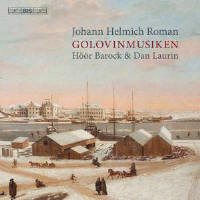Texte paru dans: / Appeared in: BIS |
|
|
Reviewer: Bertil
van Boer In 1728 the Russian ambassador to Sweden, Count Nikolai Golovin, went for a grand celebration in Stockholm in honor of the 12-year-old new Tsar, Peter II. It was a strange idea, given that Sweden and Russia had been enemies under their previous rulers, Carl XII and Peter I the Great. Although the two kingdoms were at peace, with German-born Frederick I on the Swedish throne and his ability to wage war highly restricted by a resurgent parliament, it was a political risk, given that a formal peace treaty had been signed only four years prior. Golovin, however, may have thought that a lavish banquet accompanied by suitable music would have marked the beginning of a new era. His major problem, however, was that he did not have his own musicians who could either have composed or performed any music. Therefore, he decided to commission Johan Helmich Roman, Frederick’s Hovkapellmästare, to arrange the musical portions. This further cemented the new political relationship between the powers and in turn offered Roman an opportunity to write outside his normal venues.
The result was 45 short pieces collected into a grand suite, the perfect dinner music for the time. Roman’s autograph, though complete, lacks many details, ranging from the order of the music, which apparently deviated from his autograph, to detailed instrumentation, leading the editor of the edition based on the original score to conclude that there were gaps. The score itself is written rather hastily, with some markings, such as tempos, missing altogether (they can be found scribbled into the parts, however). This gives rise to the notion that, although Golovin gave Roman leeway to arrange the performance, he may have been uncertain as to whom would actually be playing the music from the court ensemble, Hovkapellet. The parts themselves mirror this confusion, given that instrumental designations are not entirely clear and many are missing. If one goes by who was available, winds consisted of recorders, flutes, oboes, and perhaps a bassoon (or dulcian), with a continuo group of probably harpsichord, cello, violone, and viola da gamba; these in addition to a small string section of 12–15 players. Not all of them would have been used or available, and each of the woodwinds probably had multiple types of instruments (oboe d’amore, for example) at hand. This makes an actual reconstruc-tion problematic, but no matter, since conductor Dan Laurin makes it clear that he has made substantive changes according to his own interpretations and the instruments available in his ensemble Höör Barock. Given that such manipulation was not uncommon during the time, his interventions can be excused, but the caveat here is that this recording in no way actually reflects what Golovin heard while eating dessert. One final note is that the claim that this is the first “complete” recording. Technically speaking, that is true but only reflects the music itself, not the performance, but I suppose it would have been too complicated to note something like “first complete recording of the score but with modern interventions as to what instruments were used and the order in which they were originally played.”
The pieces themselves are perfect little miniatures, with only two movements being of significant length. Even the overture, quite Handelian in style with solemn dotted rhythms but lacking the following contrapuntal second section, is short and succinct. The longest, at about six and a half minutes, is a joyous and quite festive Allegro, with a jaunty melody and more than a hint of Roman’s later opening to his Drottningholms-musik from about a decade or so later. Here the Höör Ensemble employs pairs of oboes and a recorder to lend it textural contrast, as does the sudden and quite momentary excursions into a minor key. The result is quite effective, though it betrays the composer’s Baroque roots stemming from his time in England. The shortest is a brief half minute triple meter dance with a strumming guitar providing the accompaniment to the snarling oboe da caccia; here the two recorders are more subdued, so that they barely emerge from the texture. The instrumentation ranges from a Gavotte for solo mandora, which sounds delicate and even a bit early Baroque in tone, to the final Gigue in which the ensemble, replete with all woodwinds and multiple strings, not to mention an augmented continuo group, rolls along with decisive statements that emphasize the triple compound meter with a full-bodied texture. The guitar is perhaps a bit too prominent, but the doubling makes it a fitting conclusion to this sprawling suite.
Of course, to discuss each movement would take on more time than is available here, and indeed would be problematic given Laurin’s rearrangements. From a performance standpoint, the group fulfills their task with a nice set of tempos, clarity of tone, and good intonation. The mixture can be a bit strange at times, especially when the softer recorders are paired with the more prominent oboes, and, as noted, the guitar in the continuo can be more forward that I would have thought necessary (though on the other hand, the use of the mandora for the same purpose blends better, such as in the soft and pensive No. 23 Lento). But the performance is quite nice all around. If one expects that this will reflect Roman’s actual performance of the Golovin music, then this disc will not fulfill this purpose. One the other hand, given the fine performance of the group, it will provide almost an hour and a half of pleasant and well-composed music, just the right ambience for the background to a nice extended dinner.
| |
|
|
|
|
|
|
|
Cliquez l'un ou l'autre
bouton pour découvrir bien d'autres critiques de CD |
|




